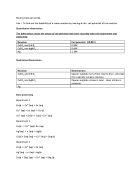Nernst Equation
Ecell = E0cell - (RT/nF)lnQ
Ecell = cell potential under nonstandard conditions (V)
E0cell = cell potential under standard conditions
R = gas constant, which is 8.31 (volt-coulomb)/(mol-K)
T = temperature (K)
n = number of moles of electrons exchanged in the electrochemical reaction (mol)
F = Faraday's constant, 96500 coulombs/mol
Q = reaction quotient, which is the equilibrium expression with initial concentrations rather than equilibrium concentrations
Purpose: To determine the effect of concentration on cell potential using the Nrest equation.
Hypothesis: An equal concentration of the solutions will result a cell potential equal to the standard because the logarithm of the reaction quotient will be 0.
Variables and Controls
Independent Variable: Concentration of copper and zinc nitrate
Dependent Variable: Voltage of half electrodes
Constant Variables:
- Room Temperature (24.5°C)
- Size of electrodes
Materials and Methods:
Materials:
50 ml beakers (x2)
U-shaped Plastic Tube
Filter Paper
Distilled water 20 ml
Voltmeter with overhead LCD display and leads with alligator clips
Copper and Zinc metal strips
1 M Copper nitrate {Cu(NO3)2} 50 ml
1 M Zinc nitrate {Zn(NO3)2} 50 ml
Potassium Nitrate (KNO3) 100 ml
Procedure:
One end of the tube was stuffed with filter paper. Potassium Nitrate was put into the tube until no bubbles were present and the other end was stopped with filter paper as well, making the salt bridge. One beaker was filled 10 ml with copper nitrate and another beaker was filled with 10 ml zinc nitrate. An end of the salt bridge was placed into each beaker. The strip of copper metal was placed into the beaker with the copper nitrate solution and the strip zinc was placed in the beaker containing zinc nitrate. Clips connected to the voltmeter were connected to each metal strip. The voltage of the cells was then recorded by the voltmeter. Then each solution was diluted by adding 10 ml distilled water into each beaker. The same procedure of recording the voltage was used.
Diagram
Raw Data
Processing Data
The standard cell potential of zinc and copper can be calculated.
The standard electrode potential of zinc is 0.76V and that of copper is 0.34V
The cell potential is the difference between the standard electrode potential values
= 0.76 +0.34 = 1V
Using the Nernst equation we can compare the electrode potentials of the metals are different concentrations.
Nernst Equation
Ecell = E0cell - (RT/nF)lnQ
Calculation for set 2:
E0cell = 1.10 V
R = 8.31
T = 24.5 C+ 273=297.65
n = 2 (Zn → Zn2+ + 2e and Cu2+ + 2e → Cu)
F = Faraday's constant, 96500 coulombs/mol
Q = [Zn2]/[ Cu2+ ]
Their concentration can be determined using the data of set one and the formula
M1V1=M2V2
The moles and volumes of both the solutions in set one are 1 M and 10 ml. The volume of the solutions in set 2 is 20 ml.
Therefore:
M1V1 /V2=M2
1x10/20=0.5
Q= 0.5/0.5=1 mol dm-3
Ecell = E0cell - (RT/nF)lnQ
= -1.01 – ( 8.31x297.65/2x95600) x ln1
=1.01-(0.01) x 0
=1.01
Conclusion
The data shows that the cell potentials are equal regardless of the concentration. This occurred because the concentrations of both solutions in the sets resulted in a reaction quotient of 0. So the effect of concentration on cell potential may not be observed and hence the hypothesis may not be supported.
Evaluation
A systematic error that occurred was that the voltmeter used to measure the voltage of the electrodes was not very sensitive which might have affected the electrode cell potential.
A random error that occurred was that during the experiment an air conditioner was running which would have affected the experiment’s surrounding temperature which would not have been constants.
Improvements
In order to make the experiment better, the concentration of only one of the solutions should be changed at a time to determine the effect of concentrations on electrode cell potential. Also to decrease the random errors the air conditioner should be turned off or the experiment should be held in a room with a constant temperature. A more sensitive voltmeter would also make the experiment more precise.







